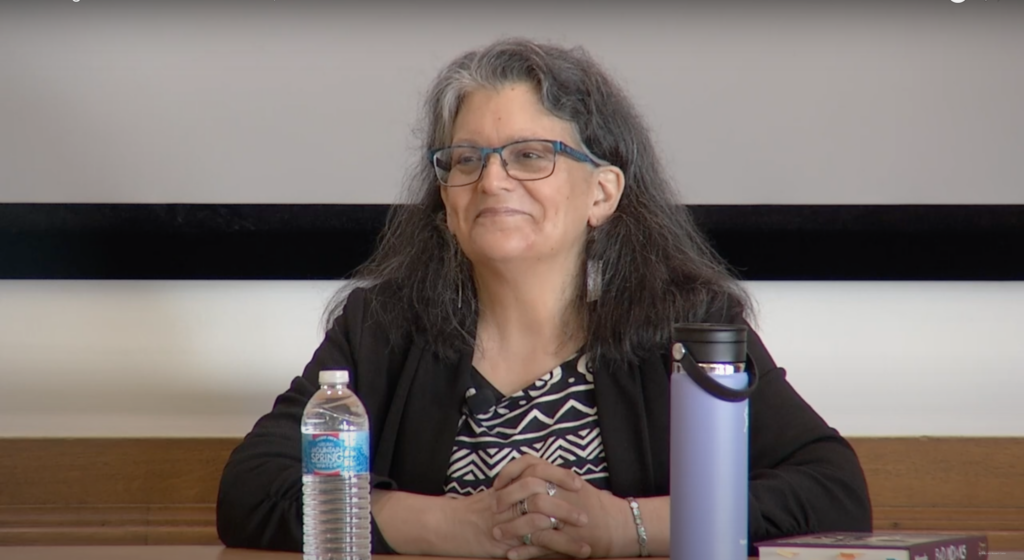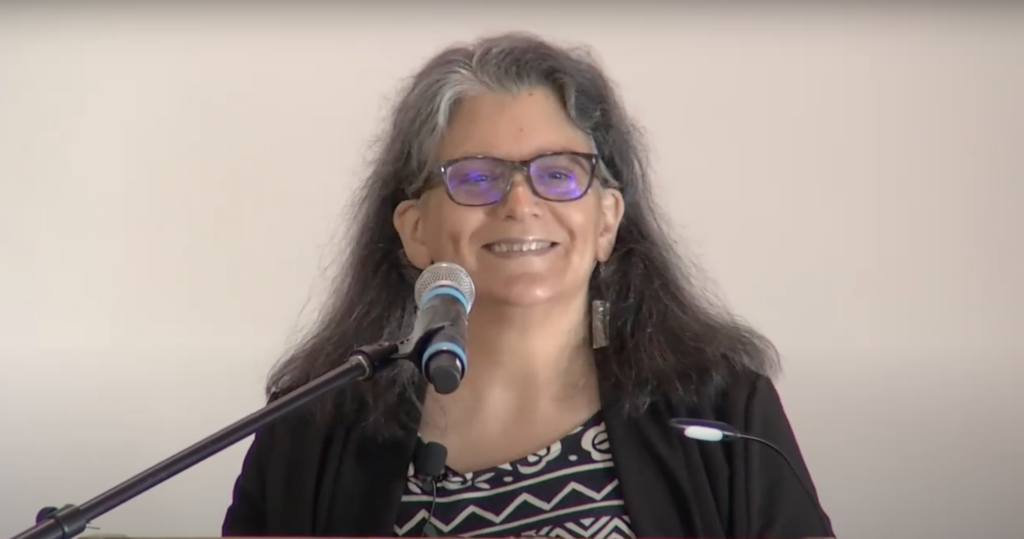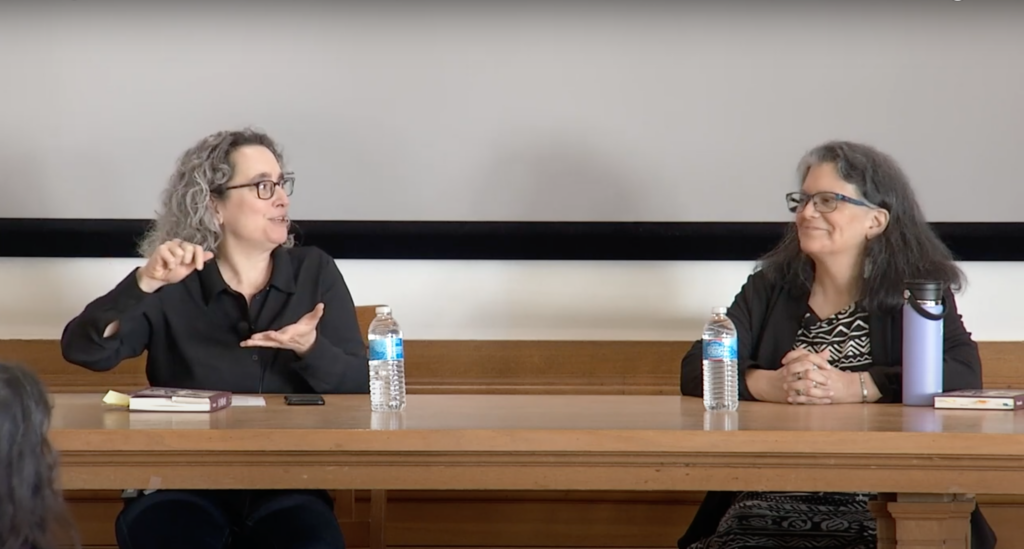by Eva Whitney, March 6, 2024
On January 29, 2024, the Arts Research Center welcomed writer Deborah Miranda for a reading followed by a conversation with Estelle Tarica, Professor of Latin American Literature and Culture and Chair of the Department of Spanish & Portuguese (event info here). The full recording of the event is available for viewing on ARC’s YouTube channel, here.

What makes a memory? Is it a fixed thing, or part of one’s imagination? Can history be considered a collective memory? Writer Deborah Miranda set out to explore these questions on January 29, 2024, through a reading of her work and a conversation with Professor Estelle Tarica. Tarica’s class, titled “Indigenous and Latinx Pathways of Memory in California” was in attendance, filling the room. She modeled her class after the concept of the “memory path,” a term revitalized in a contemporary anti-colonial context by the Bolivian indigenous scholar Silvia Rivera Cusicanqui. The term refers to “a figurative or imaginary journey across the local landscape into the past,” it is an “act of symbolic reconstruction that confronts colonial legacies and fragmentation.”
Tarica’s class’s project is directly in conversation with Miranda’s work. “Her poetry and prose are imaginative memory paths that illuminate the darkest periods of California’s history,” Tarica said in her introduction. Expansive, experimental, and thorough, Miranda’s reading was a true opening to the past, bringing in otherwise unheard fragments of personal histories of loss with Miranda as a memory keeper.
Deborah Miranda is an enrolled member of the Ohlone-Costanoan Esselen Nation in California; she has Santa Ynez Chumash, English, and French lineage. In addition to Bad Indians: A Tribal Memoir, which is the winner of the PEN Oakland Josephine Miles Literary Award, she is the author of four poetry collections and co-editor of the Lambda finalist Sovereign Erotics: An Anthology of Two-Spirit Literature. Miranda’s current projects include a collection of essays examining gender and survivance in California missions based on the stories of Isabel Meadows, a Rumesen storyteller of the 19th century, who left behind extensive documentation of Indigenous cultures and histories in and around Carmel Mission. The first piece that Miranda read, “The People Before,” is a found poem in Meadows’ voice, using fragments from her stories that Miranda discovered in the Smithsonian archives. The poem, broken up into stanzas with short lines, adopts a conversational tone, conveying detail in a way that unravels neatly and naturally, placing the reader into the scene:
“…the padre used to like
to go out to ride
en el cayuco, on that lake
on Sundays. The Indian boys
would take him out.
The cayuco was woven
of tules, I don’t know how.” (41)
Miranda’s use of “I” brings us in—it is as if she was present in the past, closing the gap between the two eras. Not only is she inhabiting Meadows’ voice, but Miranda expands into the voice of all her indigenous ancestors, and beyond. Bad Indians is a “collaborative act,” she says, “not just between [her] and [her] ancestors, but between [herself] and everybody who reads the book and everybody who teaches the book.” The “I,” then is boundless. “The People Before” ends in Meadows’s reflection:
“If they had not all died,
the Indians here,
the country would be full
of them, telling stories.” (43)
Responding to herself, Miranda said “I just want to reach back in time and say, ‘Isabel, we are.’” Our conceptions of self, or speaker, as well as time, collapse in the space her poetry carves out.

Bad Indians is an experimentation with form, moving from poetry to prose and, at times, resting somewhere in between. Divided into sections pertaining to specific time periods, Miranda led us chronologically through the book, beginning with “The End of the World: Missionization, 1770-1836” and landing in “Teheyapami Achiska: Home, 1961-present.” She read “Coyote Takes a Trip,” a prose piece that follows Coyote, the protagonist, on a journey of self-discovery. On the bus, he watches a person whom he believes to be an old woman, transfixed by their “mix of strength and serene femininity.” Soon, though, he realizes they are a two-spirited person, or an “aqi,” a word meaning “honor, medicine, truth” (214).
Miranda has the unique ability to convey critical historical information in playful, personal ways; it is an unexpected vessel for truth. In the margins, Miranda quotes missionaries commenting on aqis; their close-mindedness is even more pronounced next to Coyote’s curious nature. In one quote, Friar Francisco Palou refers to a relationship between an aqi and their partner as “an unspeakably sinful act” (214). Although Bad Indians makes space to work through the inconceivable loss and injustice experienced by Native Americans in the past, Miranda grounds us in stark, true remnants as careful reminders that these ideas still survive in modern times.

After her reading, Miranda and Tarica joined together in conversation. Tarica began by commenting on Miranda’s ability to shift between forms: “In Bad Indians, you write prose memoir, you annotate your daughter’s coloring book…There’s a lot of very subversive dialogical kinds of literature.” Miranda described how her book began as a scholarly project, an exercise of going through her grandfather’s cassette tapes to “write a very scholarly book about what it was like to be the survivor of the missions… to be born in 1903 at the very bottom of the California Indian population.”
What started as an academic pursuit quickly became personal as she unearthed tragic stories that were directly linked to her lineage. Those stories, she explained, “dictated themselves to [her] as poetry,” they warranted a looser form and space for experimentation with language. Moreover, as her research led her to collect scraps from the past, her writing called for a fragmentary form— she was filling in the gaps “[making] it just a little bit more complete, like a window.”
Miranda’s exploration of memory paths brings lost narratives to life and upends time itself, revealing how present the past is. Although her pieces are in conversation with precise details from history, such as Isabel Meadows’ words, there is an openness that brings the reader, or audience, into them. To use Miranda’s language, her writing is “reciprocal” or has a “circular motion.”
Bio: Eva Whitney is an undergraduate at UC Berkeley studying comparative literature. Born and raised in San Francisco, she attended Ruth Asawa School of the Arts for creative writing and has been immersed in the city’s art scene her entire life. She has led poetry workshops at 826 Valencia, been a gallery assistant, and currently runs a creative writing publication through the Comparative Literature Department at UC Berkeley as well as works as ARC’s communications assistant. Her work has been featured in NYU’s brio Literary Journal and BAMPFA’s Student Committee Film Festival. Having just returned from a study abroad program in Barcelona, Eva is using her final year at Berkeley to write a senior honors thesis.
